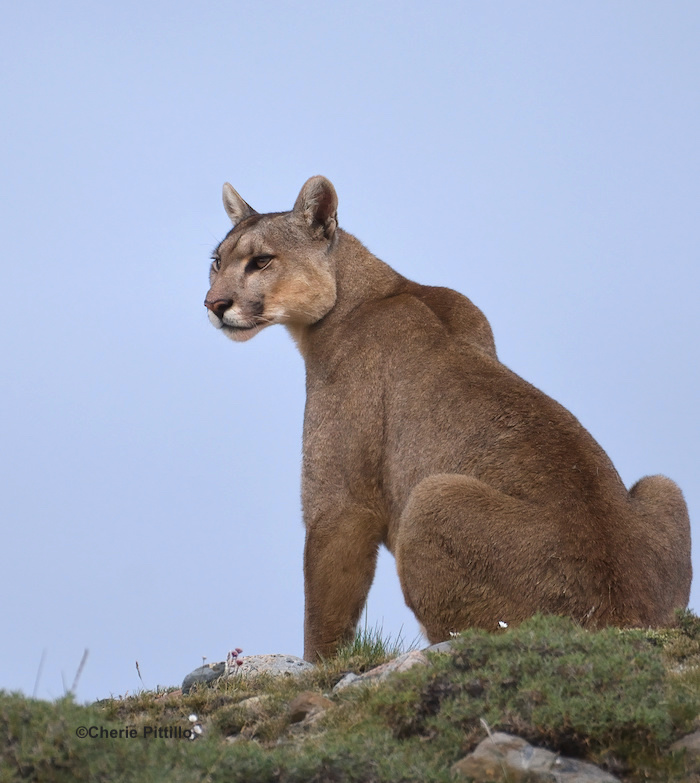PUMA CONCOLOR CONCOLOR
Welcome to my personal puma path, part 2 of 2!
Part 1 introduced common misconceptions and misrepresentations of the mountain lion or puma. Remember some of that originated from early studies in morphology to classify species and subspecies. So now let’s look at a few common characteristics of these cats.
CAT HEAD:
Excellent hearing and eyesight are well established functions. With more rods than cones in the eyes, night time vision is enhanced. Another trait you may not have noticed is the pupil contracts into a dot rather than a slit as in pet cats. However, some references state the species has a weak sense of smell. Obviously this should be corrected due to the flehmen response in Part 1 which shows scents may be enhanced by 30 times in the olfactory Jacobson’s organ. We now know the puma uses that response to determine location, territory, prey, readiness to mate, rivals, and other cats.
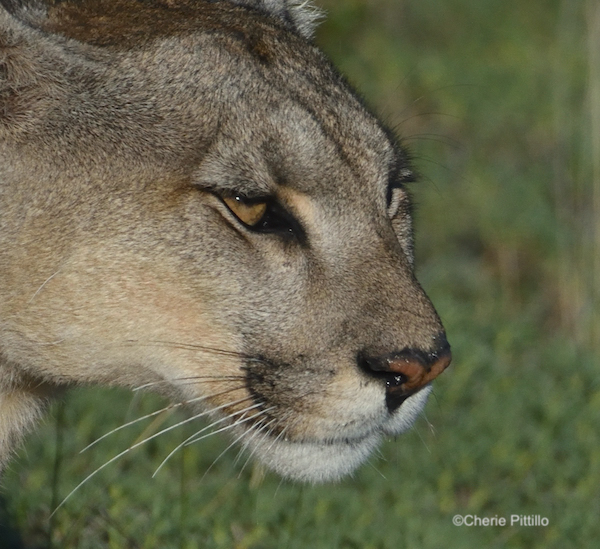
LINK TO PART 1 https://www.theyucatantimes.com/2023/11/backyard-birding-in-merida-yucatan-and-beyond-my-personal-puma-path-in-patagonia-part-1-of-2/
MUZZLE NUZZLE
Cats have a short muzzle with only 30 teeth unlike dogs and bears with 42. That muzzle aids in biting the trachea or windpipe under the neck of main prey to cut off the oxygen supply or it can also be used to break the spinal column. This image illustrates how a cub learns where to bite using mom as a test case during playtime.


SCENTSATIONAL SCENT GLANDS
I watched a puma sniff at a calafate bush, then she rubbed her face in it. Her forehead, lower ears, cheeks, whiskers, lips, and chin contain scent glands which left her scent on the bush. As if that were not enough marking, she lowered her head into the bush to continue that process. At the exact same time she urinated! That observation astounded me. Both urination and defecation aid in defining territory.





All those chemical scents provide nonverbal communication of individuals, territories, and location which can reduce conflicts. I saw many pumas smelling plants and paths during their daily forays.

Keep reading to learn more about scent gland locations.
FEELING FELINES
I never expected how much of the day was spent in moms touching their offspring or vice versa, even when the cubs were sub-adults at two years of age! The youngest cub I saw was 10 months old and nearly as large as the mom. Part of the touching involved mutual grooming where a mom and her cub cleaned each others faces or other body parts after eating. Many greetings happened where they smushed their faces together after only a few seconds apart. Actually I saw many parts of the body were used to touch or rub against another cat whether walking, running, eating, or playing. Even the tail has scent glands on it and around the base. Sometimes the mom appeared to give reassurance to the cubs by touching them.
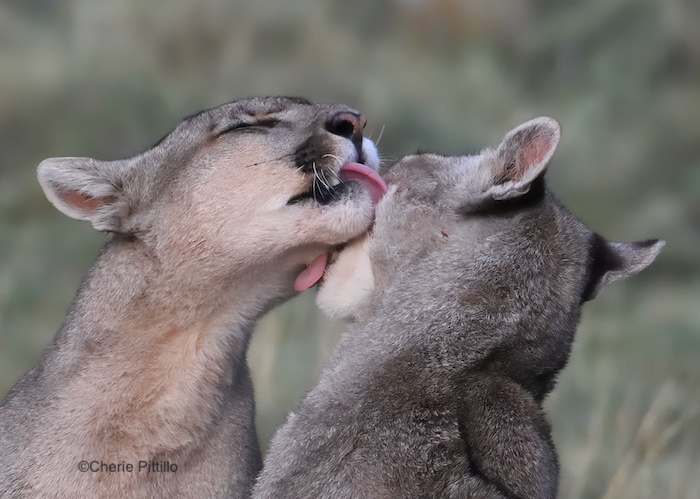



PAUSE FOR PAWS
Did you ever pause to paw-nder about paws? Pumas have five toes on the larger front feet and four toes on the back. The black toe pad forms an “M” or I would call it a “W” of three lobes. (Dogs have only two lobes.) Plus a dew claw helps to stabilize the wrist and provide extra traction especially on slippery surfaces or turning while running. Scent glands are located between the toes and emit a strong pheromone on an outstretched paw.


COLD SHOULDER?
Although our shoulders are attached to our body by bone, cat shoulder blades are attached to muscle and are “looser.” This enables the cat to improve their flexibility, to lengthen their body, and to pounce quickly on prey.

CAT NAPS
Cat naps appeared to happen after eating or later in the day before early evening. Even then the cats were still alert listening to nearby sounds. Along with the naps were a variety of yawning. Just watching them I noticed I yawned too. The fancy words for that are social facilitation even among different species. Yep, I was a copy cat.

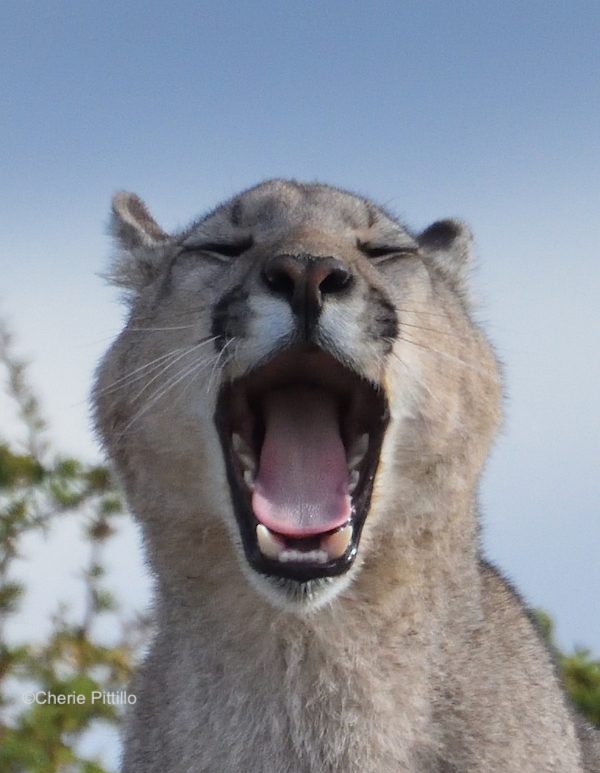
MORE THAN CAT AND MOUSE
Playing develops coordination, strength, and social bonding along with the skills to hunt and then to survive. Chasing and playing keep away aids in mental stimulation too. Take a look at this post of playing pumas!
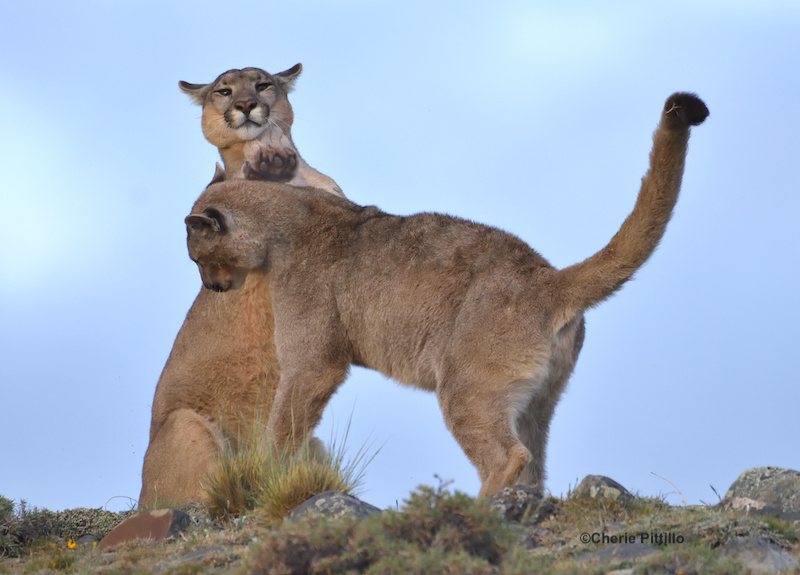
Next month I will describe in an addendum how and where to find the pumas for photography and how close three feet really is!
THE MORE TIME IN NATURE EQUALS MORE TIME TO APPRECIATE IT.
For this holiday season, may there be peace, respect, and tolerance:
MERRY CHRISTMAS, FELIZ NAVIDAD, HAPPY HANUKKAH, HAPPY KWANZAA, BUONE FESTE NATALIZIE, KURISUMASU OMEDETO, JOYEUX NOEL, FROEHLICHE WEIHNACHTEN, FELIZ NATAL, KRISMASI NJEMA, SAWAT DEE WAN, AND HAPPY HOLIDAYS
DISCLAIMER: As usual, references don’t agree especially with predator studies.
https://panthera.org/blog-post/turning-point-chilean-puma-conservation
https://onlinelibrary.wiley.com/doi/full/10.1111/mam.12281
https://panthera.org/blog-post/one-click-understand-patagonias-pumas
https://panthera.org/blog-post/importance-good-field-skills-understanding-animal-mortality
https://panthera.org/blog-post/postcard-laguna-amarga
https://forestsofthefuture.com/2022/01/24/cougars-broker-nutrients-for-485-species/
https://onlinelibrary.wiley.com/doi/10.1002/jmor.20343
https://www.britannica.com/science/hyoid-bone
https://www.ncbi.nlm.nih.gov/pmc/articles/PMC3206895/
https://journals.plos.org/plosone/article?id=10.1371/journal.pone.0027029
Cherie Pittillo, “nature inspired,” photographer and author, explores nature everywhere she goes. She’s identified 56 bird species in her Merida, Yucatan backyard view. Her monthly column features anecdotes about birding in Merida, Yucatan and also wildlife beyond the Yucatan.
Contact: [email protected] All rights reserved, ©Cherie Pittillo

